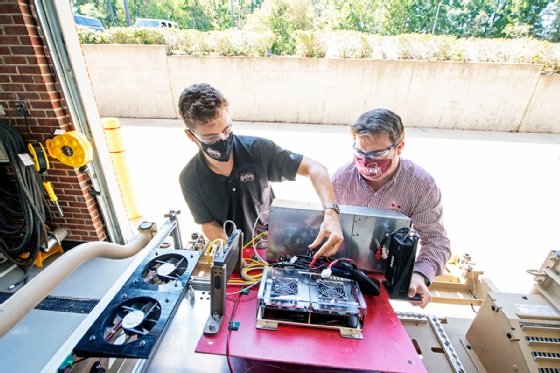
Gorodenkoff - stock.adobe.com
Ruggedized storage takes autonomous vehicle research to edge
Mississippi State University's Center for Advanced Vehicular Systems selected Quantum Corp.'s R-Series SSDs to collect sensor data at the edge.
Autonomous vehicle research often centers on city or highway use cases, but a research department at Mississippi State University wants to help vehicles master off-road driving -- and it's using ruggedized storage to get there.
The Mississippi State Center for Advanced Vehicular Systems (CAVS) is an automotive research center that works with industry and government partners and, in part, focuses on modeling and simulations for off-road, industrial and heavy-duty vehicles.
The U.S. Army approached CAVS with a new project on how to train autonomous vehicles to maneuver rough terrain, where visual indicators like traffic lights and lane markings don't exist, according to Daniel Carruth, associate director of the advanced vehicle systems group at CAVS.
"For a long time, the [Department of Defense] has been interested in reduced crews for vehicles. Maybe I can't make the vehicle fully autonomous but can give some capabilities over to the vehicle -- and instead of four soldiers in a vehicle, [there are] three," he said. "Or there's maybe one vehicle in a convoy that has a human operator in the vehicle and the other ones are just following their vehicle."
This would involve putting vehicles onto rough, even wooded terrains to gather massive amounts of data using special equipment like an inertial measurement unit (IMU) to measure the specific force, rate and orientation; and Lidar, which uses pulsed lasers to measure distances.
Collecting the data required a lot of bandwidth, so that streams of data from different sensors could be captured simultaneously. The team also had to figure out how to store all of that data, too.
Test cycles, conducted on a 50-acre site, can generate hundreds of gigabytes in as little as 60 seconds, according to Carruth. CAVS needed a storage system that could collect data locally, store it on vehicles and then transfer it to servers at the lab, where it is labeled manually and used to train machine learning models that underpin the vehicle's decision-making systems, he said.
CAVS sought out a ruggedized storage option that could handle multiple test runs a day as well as rough terrain where the data is initially collected and stored.

Data collection goes off-roading
CAVS needed storage with high capacity that could handle rough terrain and decided on Quantum's R-Series.
The Quantum R-Series are ruggedized, edge storage devices specifically designed for mobile and remote capture of both video and other IoT sensors. The series includes a removable, ruggedized magazine equipped with SSDs that can be placed onto the vehicle.
The Quantum R-Series comes in two models, the R3000, used by CAVS, and R6000, with connectivity of 10 GbE for both and performance of 1.6 GBps for the R3000 and 10 GBps for the R6000, according to the spec sheet.
The R3000 has capacity of either 23 TB or 46 TB, with CAVS using the 23 TB model, which is enough storage for its current use case. Currently, CAVS' remote monitoring equipment sensors generates about 4.2 Gbps of data during collection, which is gathered by the removable magazine. Although additional capacity is not yet needed, it is nice to have the option for when it is needed, Carruth said.
"When you go out and do data collection, take vehicles out onto the proving ground, [you want to] stay out there as long as you can [before coming in] and having to swap things out like batteries or storage devices," he said.
After a test drive is completed, team members can take the magazine from the vehicle and slide it directly into a corresponding chassis in the data center where data is downloaded to the network and made ready for analysis in CAVS' high-performance computing lab.
"The vehicle can go back out with the second magazine, while we're offloading data and moving it around [from the first magazine]," Carruth said.
Because Quantum's systems support custom scripting, CAVS can tell the magazine drive what to do on insertion. For example, existing files can automatically be transferred and removed, making the magazine ready for its next all-terrain outing.
Quantum supplied a storage product that matched CAVS' needs and now gives them room to grow, according to Graham Cousens, autonomous vehicles global account lead at Quantum. CAVS is not yet pushing the upper storage limit of the system.
"Currently, the amount of data that's been collected is relatively small," Cousens said. "But it gives our friends at CAVS plenty of headroom as their needs increase."
Navigating bumpy terrain in data
When CAVS was researching ruggedized storage for its autonomous vehicles, the Quantum R-Series seemed like a natural fit, Carruth said. CAVS needed large capacity, sufficient bandwidth for collecting data from its sensor suite, support for future expansion of sensors and ruggedness to avoid failure or damage in an off-road environment, all of which the R-Series provided.
While the ruggedized storage worked well, parts of the process for getting data from the storage magazine to the data center could be improved upon, Carruth said.
One improvement could be remote data transfer from the vehicles to the lab as opposed to swapping out magazines, he said. On the data ingestion side, CAVS would benefit from having the data automatically move into managed repositories that allowed for tagging clips and search without duplication, although this may be outside the scope of the hardware, he added.
Still, Carruth said the investment in the R-Series has been a good one.
"What [Quantum was] able to give us was support for that critical data, being able to store it and use it," he said. "They provided everything we were looking for and then some."






